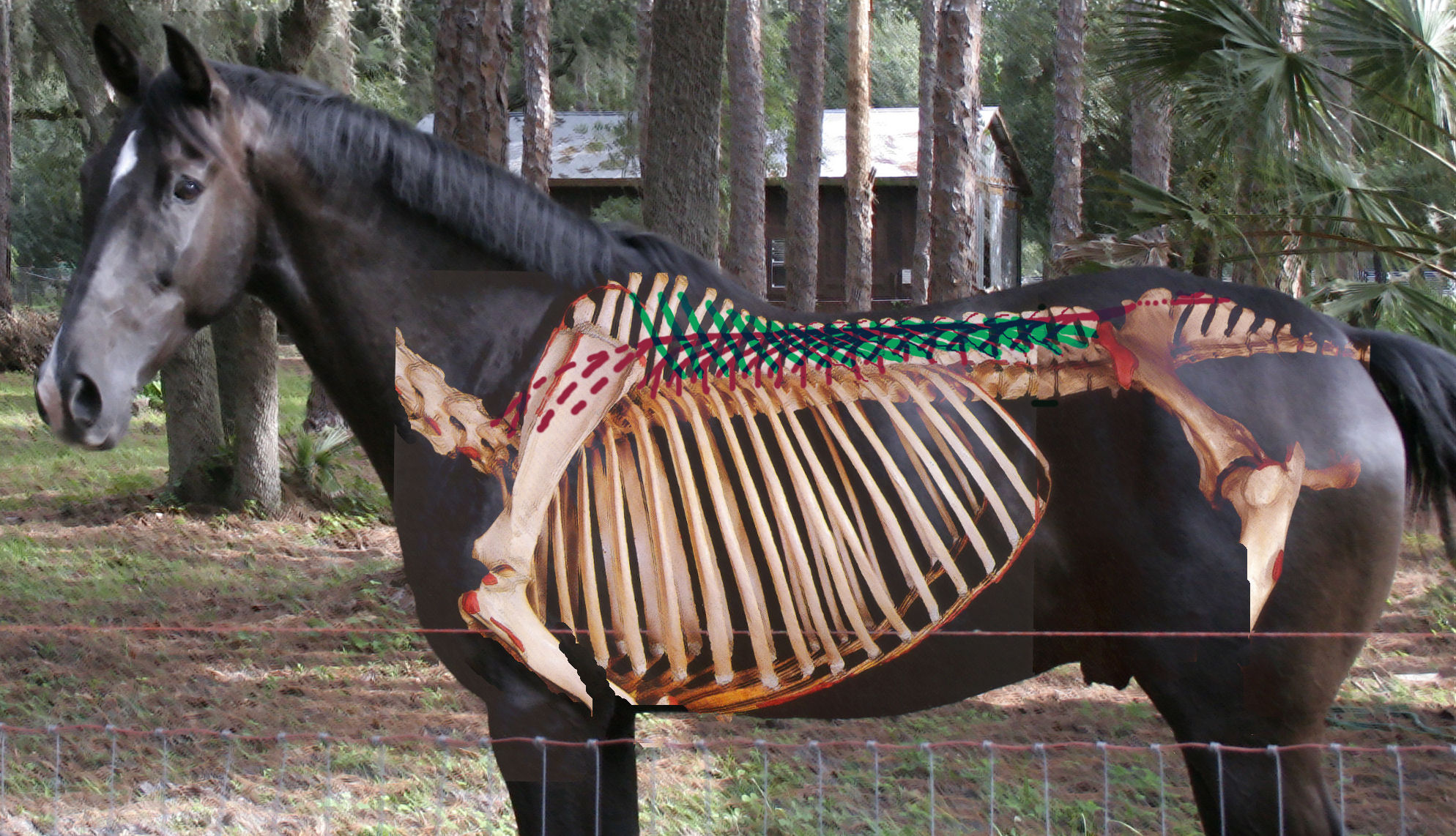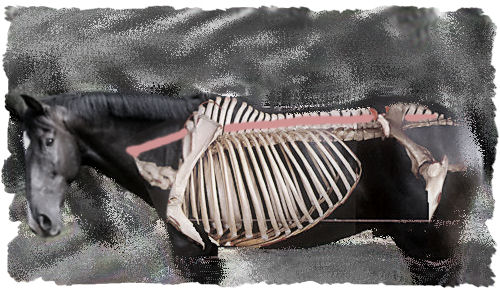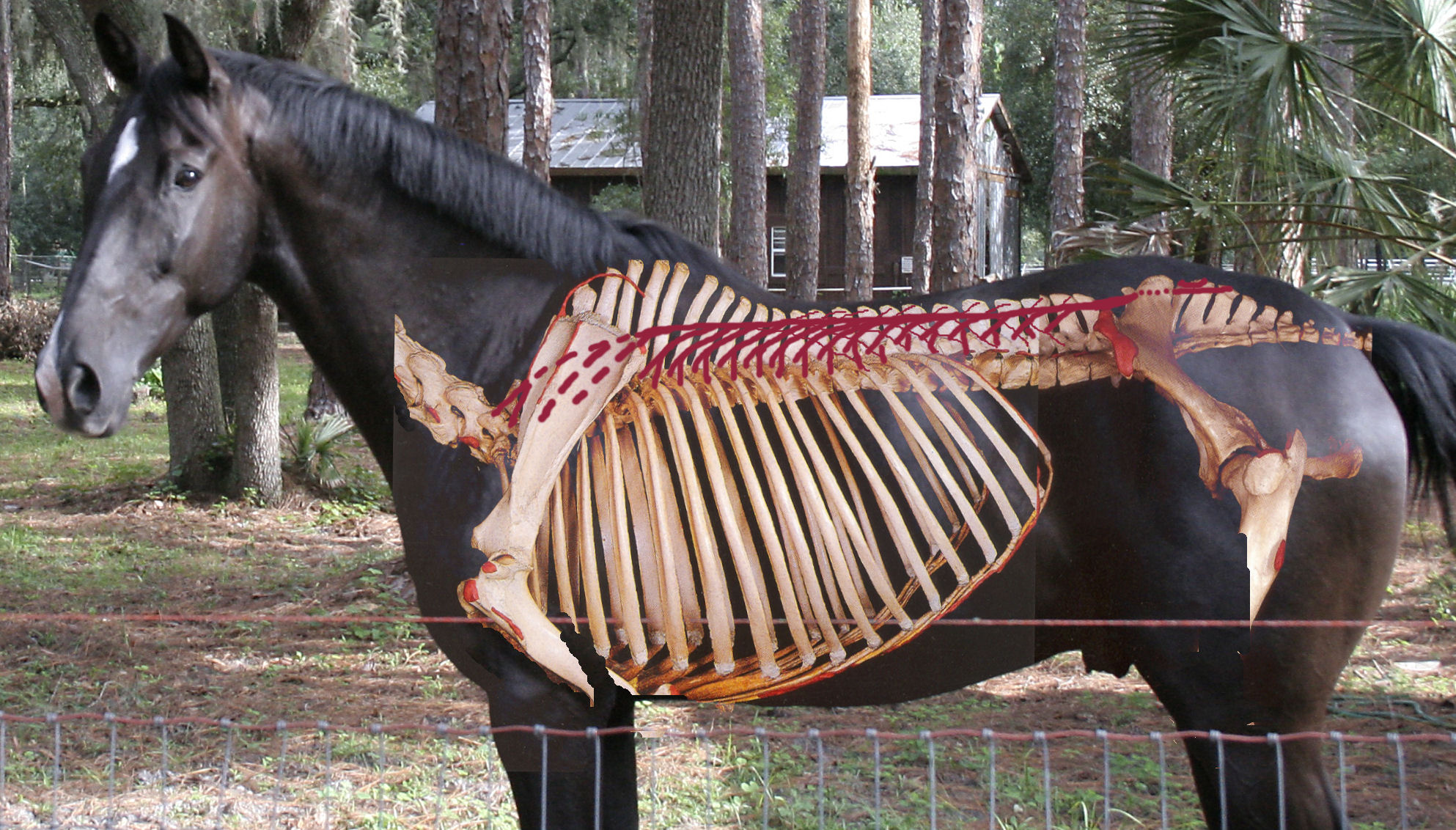Greetings!
Manchester,
March 2010, the monthly report
Manchester does have morphological flaws. His story is the classical example of a phenomenon that can be referred to as the pyramid of lameness. The concept of fitting every horse to a standard approach may help a few horses but damages many others. The morphology of each equine athlete has to be analyzed carefully since muscle imbalances and morphological flaws are going to influence the way the horse will process rider's insights and gymnastic exercises.
In the upcoming Special Manchester Newsletter, (only for the ones that have donated) we show how morphological flaws and muscle imbalances influence the horse's movements. In the last newsletter, we introduced the thought that while built upward, Manchester was functionally down-hill. The remark refers to an important component of Manchester's issues. Manchester does have a large and powerful rear end and, by comparison, a narrow chest. The horse's hind legs dominated the propulsive power of the forelegs and so when worked with a low neck posture, the result was opposite of the expected effect.
On this upcoming video you will witness Manchester's first sound step. Complex reeducations always commence with one step. The technique utilized to create the first sound step is then applied to create a sound horse. It must be understood that there is a long way between the first sound step and the horse's soundness. The focus will be on refining the conditions that prepare the horse's physique for a sound trot departure. The concentration will also be on the reasons why the horse is loosing his coordination. It might be for instance fifteen different reasons, but two or three will be more frequent. These observations will permit to better prepare the horse physique for the effort.
Already, some very pertinent training techniques, riding principles and training psychologies have been applied. Manchester's main asset is his intelligence and his willingness. Horses with such a large heart try to please the rider even though the applied technique causes physical pain and mental stress. Horses of this type can be submitted to any training technique. We encouraged Manchester to think about physical comfort and joie de vive. It did not take long for Manchester to realize that his opinions were welcomed. We do not submit any horse to a system; we guide the horse's brain toward the body coordination precisely adapted to the horse's physique.
Horses can perform, over a long period of time, at their full potential and remain sound. The secret is to focus on the athleticism required by the performance instead of hoping that repeating the performance will educate the horse's physique. Would you like to keep winning in the show ring and in the training ring for a long period of time? Would you like to understand how to prevent injuries? Would you like to better understand your horse's difficulties? Enter The Manchester Project to help us keep this program alive.
 |
Stretching and Relaxation
Myths and Reality
Jean Luc Cornille
After contraction comes relaxation. Both aspects of muscular work create movements. The quality of the movement is not proportional to the relaxation, but the intensity and timing of both the contraction and the relaxation is. In most instances, the relaxation is not a muscular slackness, but instead, a return to the initial muscle tones. This is part of the stabilization mechanism which rules proper functioning of the equine vertebral column. The same mechanism stabilizes the human's vertebral column. "The reflex contractions of the spinal column muscles compensate for the bending of the spinal column. This is a characteristic behavior of the spine stabilizing system during human movement." (Obber, J. K. 2002)
After a concentric contraction, the type that involves a shortening of the contracting muscles, the muscles then relax and return to their initial length. Technically, the muscles"stretch" as they elongate. In the case of lowering of the neck, the upper neck muscles elongate beyond their initial length. This is where myth is separated from reality.
A lowering of the neck is in fact a flexion, which is achieved by a concentric contraction of the lower neck muscles, and is aided in the task by the force of gravity that pulls the head and neck down toward earth. The upper neck muscles, situated above the cervical vertebrae, elongate to allow the lowering of the neck, but also contract to support the burden of the head and neck. When a horse is under heavy sedation, the upper neck muscles do not resist gravity and the horse's head hangs a few inches above the ground at the limit of the nuchal ligament's elastic compliance.
The work of muscles that elongate while contracting is referred to as "active stretching". The work of the upper neck muscles is also called "eccentric contraction". In terms of muscular work, eccentric contraction is the most powerful type of muscular contraction. "Muscles working eccentrically can absorb up to 15 times more energy than during concentric contractions." (R. C. Payne, P. Veenman and A. M. Wilson, 2004)
The myths suggest that as the horse lowers his neck, the upper neck muscles stretch while relaxing. But in reality, the upper neck muscles elongate as well as support the burden of the head and neck, which is as much as 10% of the horse's body weight. Hence, they do not stretch and relax, but work in active stretching, i.e., eccentric contraction.
"Everything should be made as simple as possible but not simpler." (Albert Einstein) Stretching theories are simpler. They involve two main muscle groups, the Longissimus dorsi,which connect the sacral vertebrae to the middle of the neck, (cervical vertebrae,) and the Spinaleus dorsi which extend from the wither back along the vertebral column. Both terms are generic. The longissiumus system is in fact composed of several muscles, longissimus cervicis, capitis, lumborum, ect. Oriented in mirror image direction is the spinaleussystem that refers to muscles such as the multifidius which fascicles are oriented downward and backward. Downward, means that the fascicles are oriented from the dorsal spinous processes down to the body of a vertebra situated three to five vertebrae behind. Backward, means that the fascicles are oriented toward the back.

Simplistic representations illustrate the longissimus system as a long and thick bungee cord stretching from the sacrum to the fourth cervical vertebra. Based on such schematic illustration simplistic thoughts deducted that the lowering of the neck elongated the horse's whole top line.
 
A slightly more elaborated illustration of the longissimus system as the one presented in 1946 by the Dutch scientist L.J. Slijper, demonstrates that such simplistic theory does not apply to the back muscles' structure. The longissimus dorsi muscle group is composed of fascicles bridging three to five vertebrae.

Therefore even if the upper neck muscles were pulling down and forward on the back muscles, as claimed by stretching theories, the effect would not go further back than the whither area.
Furthermore, if the upper neck muscles were pulling on the back muscles down and forward, they would not be able to support the burden of the head and neck. The horse's head would then hang a few inches above the ground at the limit of the nuchal ligament's elastic compliance, as demonstrated by the horse under heavy sedation.
CLICK HERE TO CONTINUE ARTICLE |
|
by Susan Hopf
Equestrian activities are athletic endeavors that create challenges for both horse and human. Horses are, by nature, strong-bodied, individuals with active minds that can at times react without thought for any nearby humans. To help minimize the innate dangers of spending time with horses a clear understanding of equine behavior and how it relates to human handling is a must. That and a human form that can actually "handle" whatever the horse may do.
First and foremost you, as the human element, should be aware of the demands put upon one's body when associating with horses both from the ground and mounted. Physical fitness is a necessity in order to ensure your own safety and ability to deal with a calm horse. Young horses, those that have some behavior issues and green trained mounts require an elevated level of fitness for those working with such animals.
The level of fitness to which a pleasure rider should aspire is one that addresses core strength and balance. Yoga, Tai Chi, pilates along with a good cardio-vascular routine is vital. At minimum, in order to influence your horse, you must be able to maintain your own position (core strength), separate to some extent your left side from your right (flexibility) and to an even greater extent you must be able to separate your seat from your hands (combines core strength with lateral flexibility). Building on this basic level of fitness cardio-vascular endurance will allow you to keep up with the increasing demands from the horse as she increases her level of fitness.
CLICK HERE TO CONTINUE | |
|
Jean Luc and I love hearing from you and are happy so many of you are active in keeping your horse's sound while attaining your goals in training your equine partner.
Sincerely,
Editor Helyn Cornille
Science Of Motion |
When you donate to Manchester's Last chance then register on SOM HERE and you will have complete access to all of the articles and videos on Manchesters. |
|
|
|
Jean Luc Onboard Chazot Video
|
One Hand On His Shoulder
Jean Luc Cornille

One hand On His Shoulder
DVD/Video
The most extraordinary in hand performance ever produced.
This is the masterpiece
The Performances, the Pictures, the Script, the Philosophy,
the Humor, the Music, the Relationship Between the Horse and the Man.
You don't need to be a horse person to love this production.
This is about beauty, friendship and art.
"I started the work in hand as a scientific experiment. The purpose was to see if a horse trained to always coordinate his body for the performance was capable to coordinate his physique by himself when a rider was asking for the movement. Knowing that as long as I will be on the saddle I will unconsciously help the horse, the thought was that such help would be impossible in hand. The horse, and all other horses after him, redirected the experiment toward a very different direction. The horse taught me as he will to everyone watching this video, a totally new equestrian philosophy." Jean Luc
Jean Luc's name is usually associated with science. In Jean Luc's mind, science is only the tool that supports the equestrian art.
This video is not about science but rather about art, or more exactly what science can do to the equestrian art.
Love the harmony and cherished relationship your videos bring to viewers. One hand on shoulder, wow! The gesture is so simple and yet so full of trust and love and shared being in the moment. Thank you!George Buggs
"One Hand On His Shoulder" is an amazing bit of fresh air. Breaking with tradition Jean Luc Cornille demonstrates, with great intellect and humor, just how much the horse can teach the humans with which they interact. With grace and artistry Mr. Cornille presents his work in-hand with Lafayette clearly showing that so much more can be accomplished if we accept and listen to the horse. A lovely video that brings back the art of horsemanship and has certainly inspired me to listen more and demand less of each horse I work with. Susan Hopf
Join a man and a horse on an extraordinary and beautiful journey to a new level of communication and mutual respect. An accident that could have ended the horse's life, not just his competitive career, instead provided an opportunity. The man and the horse together found a path that allowed them to explore intelligence and communication beyond that experienced by the typical horse and rider. Join Jean Luc and Lafayette II on an amazing exploration of in-hand work that allows both the man and the horse to expand their understanding of each other.Susan Schoettle

$39.95 Plus Shipping
"One Hand on His Shoulder" - a review
by Susan Hopf
CLICK HERE FOR REVIEW |
The Horse That Could Not Trot
English and French Version

"The story of "The Horse that Could Not Trot" is a fascinating journey of rehabilitation guided by a blend of classical dressage riding and the application of modern biomechanics. The young horse in the CD could not carry a rider at trot. Jean Luc Cornille used logic based on the science of motion to locate the root cause of the problem in a debilitating habit of motion. Rational choices for training and strengthening exercises arose from this analysis. In time the horse developed as his potential originally suggested to become a picture of elegance under saddle. The result is inspirational. The CD allows us to witness the progress of this horse almost as if we were at the scene over the months of progressive work. The documentary is skillfully photographed and presented, allowing us to relive a true dressage adventure. This is an extraordinary lesson in practical training. Any viewer will come away with much more than a warm heart by following through the clearly discussed analysis of the problem and the steps taken toward remediation.
Jean Luc approaches his challenge drawing on the wisdom of the traditional masters, especially de la Gueriniere, combined with a deep understanding of the functional anatomy of the horse given by more modern scientific investigations. The anatomical illustrations are especially noteworthy for their clarity. These illustrations are combined with high quality video clips of horses in motion. Seeing them together is what really makes clear the connection between the horse's skeletal alignment while in motion and either a balanced, supple gait or a strained, damaging gait. This horse's problem may be unique, but in using this case Jean Luc has provided insights into the biomechanics of horse and rider that throw light on all sorts of training issues. I will enjoy viewing this video many times over for guidance in riding and training my own horse. I recommended it especially to people who enjoy thinking about how horses move in that magical way they can".Bradley Bockrath
Total with shipping
$56.95 USD
|
|
Visit our Products Site
All profits goes to Manchesters
Last Chance!
Many with Jean Luc Cornilles cartoon. Shirts, hats, etc.
|
|
|